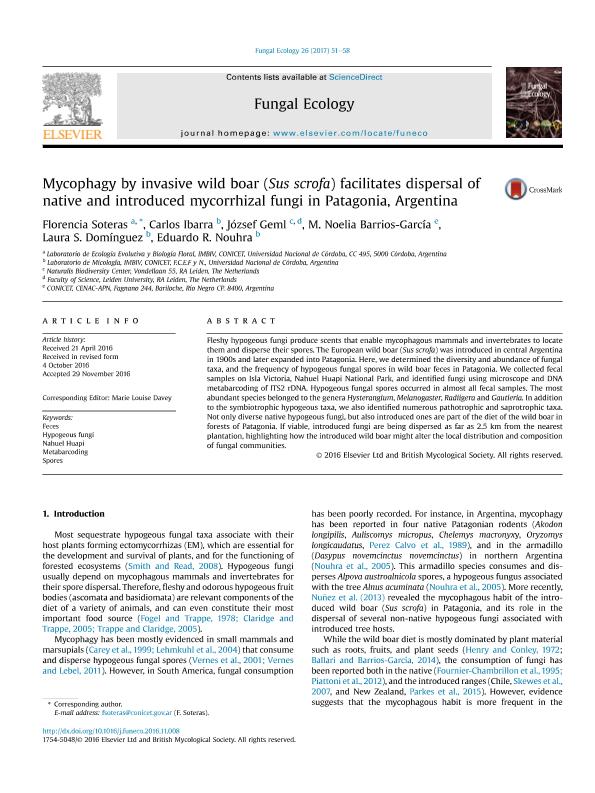Artículo
Mycophagy by invasive wild boar (Sus scrofa) facilitates dispersal of native and introduced mycorrhizal fungi in Patagonia, Argentina
Soteras, María Florencia ; Ibarra, Carlos; Geml, József; Barrios Garcia Moar, Maria Noelia
; Ibarra, Carlos; Geml, József; Barrios Garcia Moar, Maria Noelia ; Dominguez, Laura Susana; Nouhra, Eduardo Ramon
; Dominguez, Laura Susana; Nouhra, Eduardo Ramon
 ; Ibarra, Carlos; Geml, József; Barrios Garcia Moar, Maria Noelia
; Ibarra, Carlos; Geml, József; Barrios Garcia Moar, Maria Noelia ; Dominguez, Laura Susana; Nouhra, Eduardo Ramon
; Dominguez, Laura Susana; Nouhra, Eduardo Ramon
Fecha de publicación:
04/2017
Editorial:
Elsevier
Revista:
Fungal Ecology
ISSN:
1754-5048
Idioma:
Inglés
Tipo de recurso:
Artículo publicado
Clasificación temática:
Resumen
Fleshy hypogeous fungi produce scents that enable mycophagous mammals and invertebrates to locate them and disperse their spores. The European wild boar (Sus scrofa) was introduced in central Argentina in 1900s and later expanded into Patagonia. Here, we determined the diversity and abundance of fungal taxa, and the frequency of hypogeous fungal spores in wild boar feces in Patagonia. We collected fecal samples on Isla Victoria, Nahuel Huapi National Park, and identified fungi using microscope and DNA metabarcoding of ITS2 rDNA. Hypogeous fungal spores occurred in almost all fecal samples. The most abundant species belonged to the genera Hysterangium, Melanogaster, Radiigera and Gautieria. In addition to the symbiotrophic hypogeous taxa, we also identified numerous pathotrophic and saprotrophic taxa. Not only diverse native hypogeous fungi, but also introduced ones are part of the diet of the wild boar in forests of Patagonia. If viable, introduced fungi are being dispersed as far as 2.5 km from the nearest plantation, highlighting how the introduced wild boar might alter the local distribution and composition of fungal communities.
Palabras clave:
Feces
,
Hypogeous Fungi
,
Metabarcoding
,
Nahuel Huapi
,
Spores
Archivos asociados
Licencia
Identificadores
Colecciones
Articulos(CCT - PATAGONIA NORTE)
Articulos de CTRO.CIENTIFICO TECNOL.CONICET - PATAGONIA NORTE
Articulos de CTRO.CIENTIFICO TECNOL.CONICET - PATAGONIA NORTE
Articulos(IMBIV)
Articulos de INST.MULTIDISCIPL.DE BIOLOGIA VEGETAL (P)
Articulos de INST.MULTIDISCIPL.DE BIOLOGIA VEGETAL (P)
Citación
Soteras, María Florencia; Ibarra, Carlos; Geml, József; Barrios Garcia Moar, Maria Noelia; Dominguez, Laura Susana; et al.; Mycophagy by invasive wild boar (Sus scrofa) facilitates dispersal of native and introduced mycorrhizal fungi in Patagonia, Argentina; Elsevier; Fungal Ecology; 26; 4-2017; 51-58
Compartir
Altmétricas



